牛津译林版(2019)必修 第二册Unit 4 Exploring literature课件(共15张PPT)
文档属性
| 名称 | 牛津译林版(2019)必修 第二册Unit 4 Exploring literature课件(共15张PPT) |
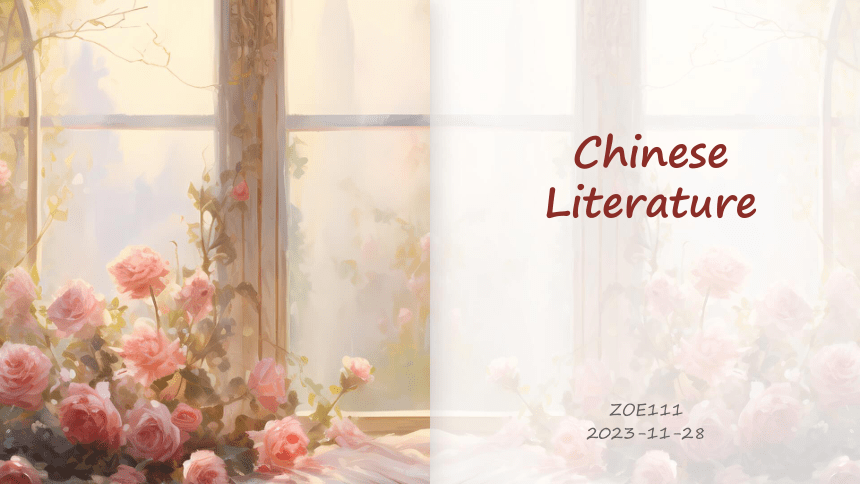
|
|
| 格式 | pptx | ||
| 文件大小 | 1.8MB | ||
| 资源类型 | 教案 | ||
| 版本资源 | 牛津译林版(2019) | ||
| 科目 | 英语 | ||
| 更新时间 | 2023-11-28 21:47:51 | ||
图片预览

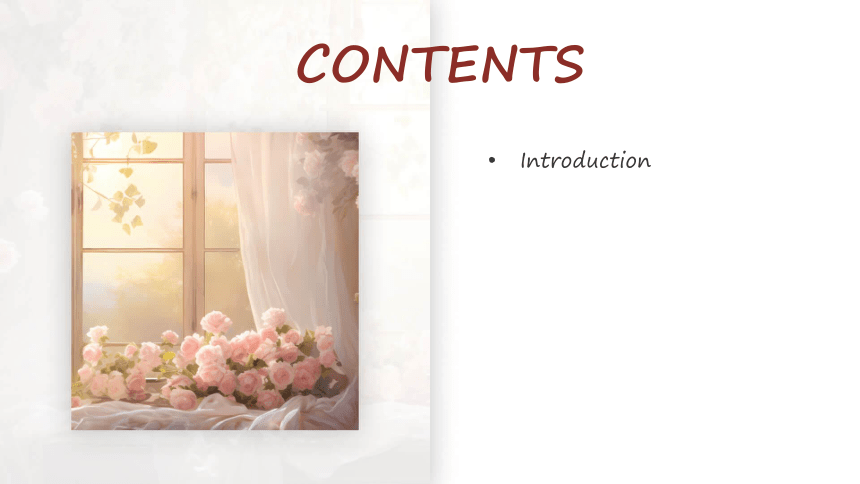

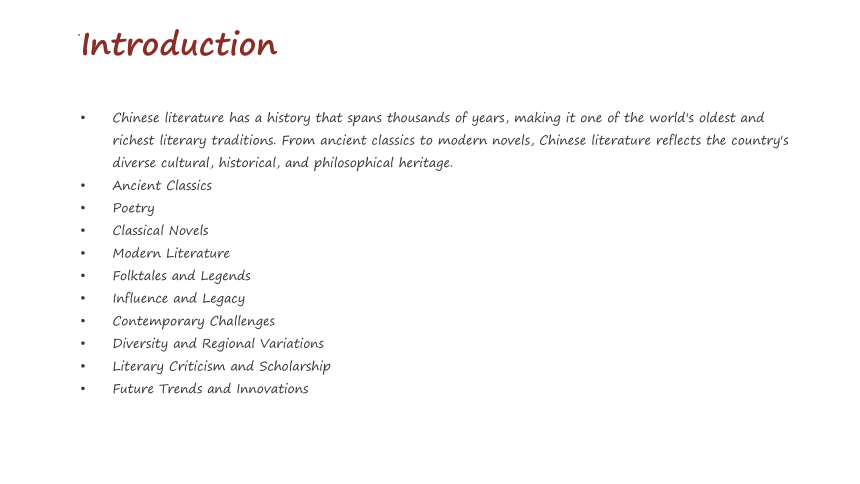
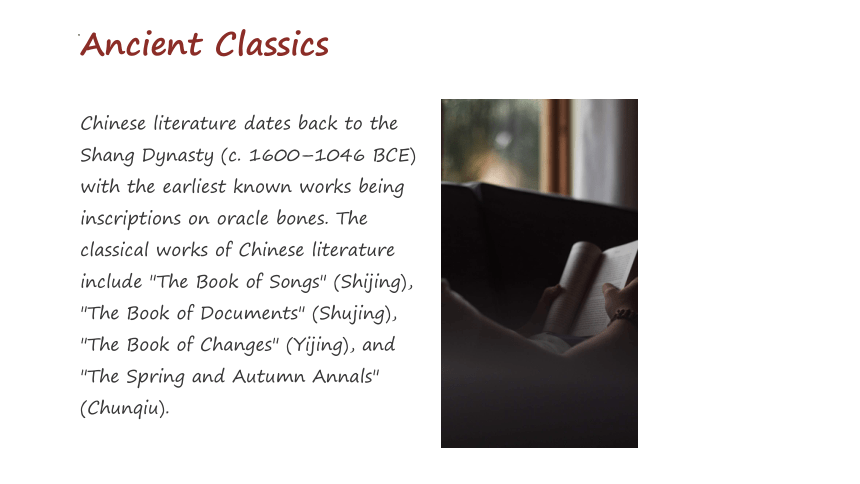
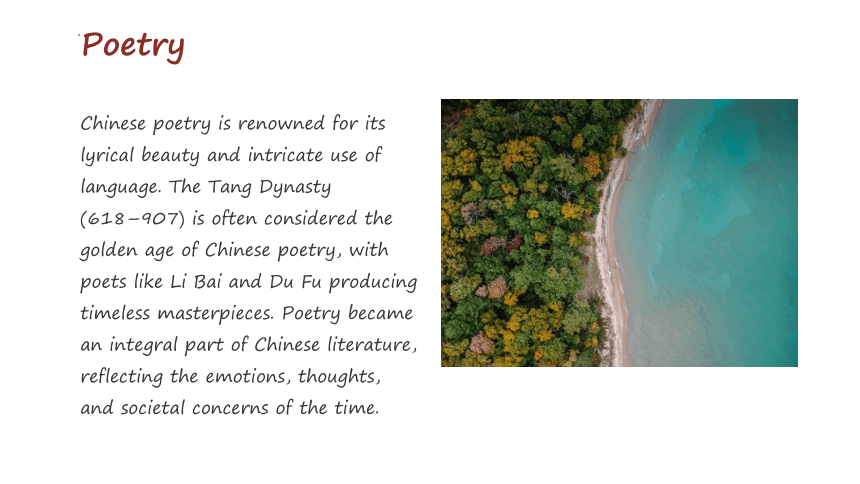
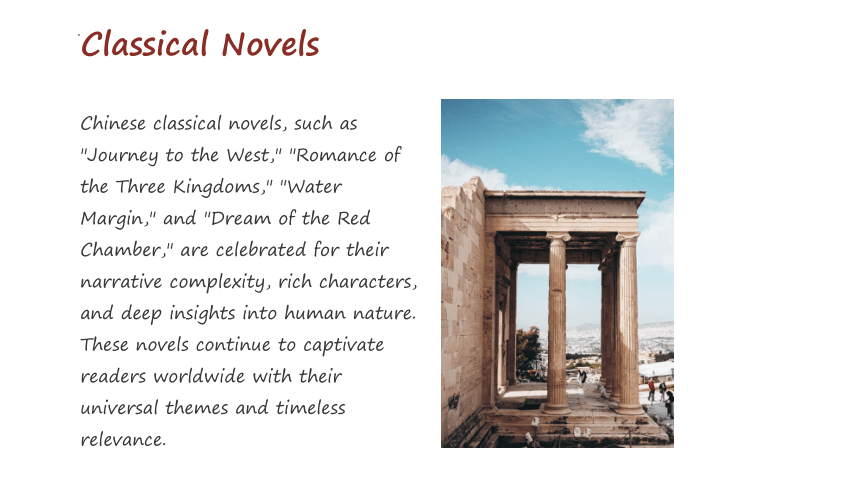
文档简介
(共15张PPT)
Chinese Literature
ZOE111
2023-11-28
CONTENTS
Introduction
01
Introduction
Introduction
Chinese literature has a history that spans thousands of years, making it one of the world's oldest and richest literary traditions. From ancient classics to modern novels, Chinese literature reflects the country's diverse cultural, historical, and philosophical heritage.
Ancient Classics
Poetry
Classical Novels
Modern Literature
Folktales and Legends
Influence and Legacy
Contemporary Challenges
Diversity and Regional Variations
Literary Criticism and Scholarship
Future Trends and Innovations
Ancient Classics
Chinese literature dates back to the Shang Dynasty (c. 1600–1046 BCE) with the earliest known works being inscriptions on oracle bones. The classical works of Chinese literature include "The Book of Songs" (Shijing), "The Book of Documents" (Shujing), "The Book of Changes" (Yijing), and "The Spring and Autumn Annals" (Chunqiu).
Poetry
Chinese poetry is renowned for its lyrical beauty and intricate use of language. The Tang Dynasty (618–907) is often considered the golden age of Chinese poetry, with poets like Li Bai and Du Fu producing timeless masterpieces. Poetry became an integral part of Chinese literature, reflecting the emotions, thoughts, and societal concerns of the time.
Classical Novels
Chinese classical novels, such as "Journey to the West," "Romance of the Three Kingdoms," "Water Margin," and "Dream of the Red Chamber," are celebrated for their narrative complexity, rich characters, and deep insights into human nature. These novels continue to captivate readers worldwide with their universal themes and timeless relevance.
Modern Literature
In the 20th and 21st centuries, Chinese literature has undergone significant transformations, reflecting the country's modernization and engagement with global literary trends. Writers like Lu Xun, Ba Jin, Eileen Chang, Mo Yan, and Yu Hua have made profound contributions to modern Chinese literature, addressing complex social issues and exploring the human condition in a rapidly changing society.
Folktales and Legends
Chinese literature also encompasses a rich tapestry of folktales and legends, passed down through generations. These stories often carry moral lessons, cultural insights, and fantastical elements, offering a glimpse into the values and beliefs of Chinese society across different dynasties.
Influence and Legacy
The influence of Chinese literature extends beyond its borders, shaping the literary traditions of East Asia and influencing global literature. Chinese literary works continue to inspire writers, scholars, and readers worldwide, serving as a bridge between cultures and a testament to the enduring power of storytelling.
Contemporary Challenges
In contemporary China, literature continues to evolve amidst shifting political and social landscapes. Writers navigate censorship, commercial pressures, and the complexities of cultural representation, presenting both challenges and opportunities for the future of Chinese literature.
Diversity and Regional Variations
Chinese literature encompasses a wide range of regional styles and dialects, reflecting the diverse cultural landscapes within China. Regional variations in literary expression offer a multifaceted view of Chinese society and contribute to the richness and complexity of the country's literary heritage.
Literary Criticism and Scholarship
The study of Chinese literature has garnered widespread scholarly attention, leading to diverse critical interpretations and analyses of literary works. Literary criticism plays a crucial role in deepening our understanding of Chinese literature and its impact on global literary discourse.
Future Trends and Innovations
As Chinese literature continues to evolve, emerging writers and literary innovators are redefining the boundaries of literary expression. From experimental forms to digital literature, the future of Chinese literature holds promise for new artistic frontiers and creative expansions.
THE END
THANKS
Chinese Literature
ZOE111
2023-11-28
CONTENTS
Introduction
01
Introduction
Introduction
Chinese literature has a history that spans thousands of years, making it one of the world's oldest and richest literary traditions. From ancient classics to modern novels, Chinese literature reflects the country's diverse cultural, historical, and philosophical heritage.
Ancient Classics
Poetry
Classical Novels
Modern Literature
Folktales and Legends
Influence and Legacy
Contemporary Challenges
Diversity and Regional Variations
Literary Criticism and Scholarship
Future Trends and Innovations
Ancient Classics
Chinese literature dates back to the Shang Dynasty (c. 1600–1046 BCE) with the earliest known works being inscriptions on oracle bones. The classical works of Chinese literature include "The Book of Songs" (Shijing), "The Book of Documents" (Shujing), "The Book of Changes" (Yijing), and "The Spring and Autumn Annals" (Chunqiu).
Poetry
Chinese poetry is renowned for its lyrical beauty and intricate use of language. The Tang Dynasty (618–907) is often considered the golden age of Chinese poetry, with poets like Li Bai and Du Fu producing timeless masterpieces. Poetry became an integral part of Chinese literature, reflecting the emotions, thoughts, and societal concerns of the time.
Classical Novels
Chinese classical novels, such as "Journey to the West," "Romance of the Three Kingdoms," "Water Margin," and "Dream of the Red Chamber," are celebrated for their narrative complexity, rich characters, and deep insights into human nature. These novels continue to captivate readers worldwide with their universal themes and timeless relevance.
Modern Literature
In the 20th and 21st centuries, Chinese literature has undergone significant transformations, reflecting the country's modernization and engagement with global literary trends. Writers like Lu Xun, Ba Jin, Eileen Chang, Mo Yan, and Yu Hua have made profound contributions to modern Chinese literature, addressing complex social issues and exploring the human condition in a rapidly changing society.
Folktales and Legends
Chinese literature also encompasses a rich tapestry of folktales and legends, passed down through generations. These stories often carry moral lessons, cultural insights, and fantastical elements, offering a glimpse into the values and beliefs of Chinese society across different dynasties.
Influence and Legacy
The influence of Chinese literature extends beyond its borders, shaping the literary traditions of East Asia and influencing global literature. Chinese literary works continue to inspire writers, scholars, and readers worldwide, serving as a bridge between cultures and a testament to the enduring power of storytelling.
Contemporary Challenges
In contemporary China, literature continues to evolve amidst shifting political and social landscapes. Writers navigate censorship, commercial pressures, and the complexities of cultural representation, presenting both challenges and opportunities for the future of Chinese literature.
Diversity and Regional Variations
Chinese literature encompasses a wide range of regional styles and dialects, reflecting the diverse cultural landscapes within China. Regional variations in literary expression offer a multifaceted view of Chinese society and contribute to the richness and complexity of the country's literary heritage.
Literary Criticism and Scholarship
The study of Chinese literature has garnered widespread scholarly attention, leading to diverse critical interpretations and analyses of literary works. Literary criticism plays a crucial role in deepening our understanding of Chinese literature and its impact on global literary discourse.
Future Trends and Innovations
As Chinese literature continues to evolve, emerging writers and literary innovators are redefining the boundaries of literary expression. From experimental forms to digital literature, the future of Chinese literature holds promise for new artistic frontiers and creative expansions.
THE END
THANKS
